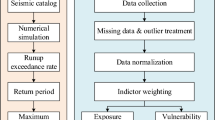Abstract
For Probabilistic Tsunami Hazard Analysis (PTHA), we propose a logic-tree approach to construct tsunami hazard curves (relationship between tsunami height and probability of exceedance) and present some examples for Japan for the purpose of quantitative assessments of tsunami risk for important coastal facilities. A hazard curve is obtained by integration over the aleatory uncertainties, and numerous hazard curves are obtained for different branches of logic-tree representing epistemic uncertainty. A PTHA consists of a tsunami source model and coastal tsunami height estimation. We developed the logic-tree models for local tsunami sources around Japan and for distant tsunami sources along the South American subduction zones. Logic-trees were made for tsunami source zones, size and frequency of tsunamigenic earthquakes, fault models, and standard error of estimated tsunami heights. Numerical simulation rather than empirical relation was used for estimating the median tsunami heights. Weights of discrete branches that represent alternative hypotheses and interpretations were determined by the questionnaire survey for tsunami and earthquake experts, whereas those representing the error of estimated value were determined on the basis of historical data. Examples of tsunami hazard curves were illustrated for the coastal sites, and uncertainty in the tsunami hazard was displayed by 5-, 16-, 50-, 84- and 95-percentile and mean hazard curves.
Access this chapter
Tax calculation will be finalised at checkout
Purchases are for personal use only
Preview
Unable to display preview. Download preview PDF.
Similar content being viewed by others
References
Abe, K. (1999), Quantification of historical tsunamis by the Mt scale, Zisin, ser. 2, 52, 369–377 (in Japanese).
Aida, I. (1978), Reliability of a tsunami source model derived from fault parameters, J. Physics Earth 26, 57–73.
Cornell, C.A. (1968), Engineering seismic risk analysis, Bull. Seismol. Soc. Am. 58, 1583–1606.
Cramer, C.H., Petersen, M.D. and Reichle, M.S. (1996), A Monte Carlo approach in estimating uncertainty for a seismic hazard assessment of Los Angeles, Ventura and Orange Counties, California, Bull. Seismol. Soc. Am. 86, 1681–1691.
Earthquake Research Committee, Regarding Methods for Evaluating Long-term Probability of Earthquake Occurrence (Publications of Earthquake Research Committee for 2000, 2001), pp. 511–590 (in Japanese).
Earthquake Research Committee, Long-term Evaluation of Seismicity along the Japan Trench from off Sanriku to off Boso (Publications of Earthquake Research Committee for 2001, 2002), pp. 541–604 (in Japanese).
Ellsworth, W.L., Matthews, M.V., Nadeau, R.M., Nishenko, S.P., Reasenberg, P.A., and Simpson, R.W., A Physically-based Earthquake Recurrence Model for Estimation of Long-term Earthquake Probabilities (Workshop on Earthquake Recurrence: State of the Art and Directions for the Future, Istituto Nazionale de Geofisica, Rome, Italy, 22–25 February, 1999).
Ishibashi, K. (2003), The 1677 Empo off Boso tsunami earthquake studied from historical documents, Chikyu Monthly 25, 382–388 (in Japanese).
Kanamori, H. (1972), Mechanism of tsunami earthquakes, Phys. Earth Planet. Inter. 6, 246–259.
Kanamori, H. and Anderson, D.L. (1975), Theoretical basis of some empirical relations in seismology, Bull. Seismol. Soc. Am. 65, 1073–1095.
Matthews, M.V., Ellsworth, W.L., and Reasenberg, P.A. (2002), A Brownian model for recurrent earthquakes, Bull. Seismol. Soc. Am. 92, 2233–2250.
Pacific Gas and Electric Company, Final Report of the Diablo Canyon Long-Term Seismic Program (U.S. Nuclear Regulatory Commission, 1988), 50–275 and 50–323.
Power, W.L., Downes, G.L., and Stirling, M (2005), Estimating the tsunami hazard in New Zealand from earthquakes on the interface of the South American and Nazca Plates, abstract for International Workshop Tsunami hazard Mitigation and Risk Assessment (submitted to Pure Appl. Geophys.).
Satake, K. and Tanioka, Y. (1999), Source of tsunami and tsunamigenic earthquakes in subduction zones, Pure Appl. Geophys. 154, 467–483.
Senior Seismic Hazard Analysis Committee (SSHAC), Recommendations for Probabilistic Seismic Hazard Analysis: Guidance on Uncertainty and Use of Experts (U.S. Nuclear Regulatory Commission, NUREG/CR-6372, Washington, DC., 1997).
Seno, T. (2002), Tsunami earthquakes as transient phenomena, Geophys. Res. Lett. 29, doi: 10.10129/2002GL014868.
Takemura, M. (1998), Scaling law for Japanese intraplate earthquakes in special relations to the surface faults and damages, Zisin, ser. 2, 51, 211–228 (in Japanese).
Tanioka, Y. and Satake, K. (1996), Fault parameters of the 1896 Sanriku tsunami earthquake estimated from tsunami numerical modeling, Geophys. Res. Lett. 23, 1549–1552.
Thio, H.K., Ichinose, G., and Somerville, P. (2005), Probabilistic tsunami hazard analysis, IASPEI 2005, abstract Mo. 636.
Usami, T., Historical earthquakes in Japan, In International Handbook of Earthquake and Engineering Seismology (eds. Lee, W.H.K., Kanamori, H., Jennings, P.C. and Kisslinger, C.), pp. 799–802 (Academic Press, 2002).
Watanabe, H., Comprehensive List of Tsunamis to Hit the Japanese Islands (2nd ed.), (Univ. Tokyo Press, 1988).
Wesnousky, S.G., Scholz, C.H., Shimazaki, K., and Matsuda, T. (1984), Integration of geological and seismological data for the analysis of seismic hazard: A case study of Japan, Bull. Seismol. Soc. Am. 74, 687–708.
WGCEP (Working Group on California Earthquake Probabilities) (1995). Seismic hazards in southern California: Probable earthquakes, 1994 to 2024, Bull. Seismol. Soc. Am. 85, 379–439.
Yanagisawa, K., Imamura, F., Sakakiyama, T., Annaka, T., Takeda, T., and Shuto, N. (2007), Tsunami Assessment Method for Nuclear Power Facilities in Japan, Pure. Appl. Geophys. this volume.
Youngs, R.R. and Coppersmith, K.J. (1985), Implications of fault slip rates and earthquake recurrence models to probabilistic seismic hazard estimates, Bull. Seismol. Soc. Am. 75, 939–964.
Author information
Authors and Affiliations
Editor information
Editors and Affiliations
Rights and permissions
Copyright information
© 2007 Birkhäuser Verlag, Basel
About this paper
Cite this paper
Annaka, T., Satake, K., Sakakiyama, T., Yanagisawa, K., Shuto, N. (2007). Logic-tree Approach for Probabilistic Tsunami Hazard Analysis and its Applications to the Japanese Coasts. In: Satake, K., Okal, E.A., Borrero, J.C. (eds) Tsunami and Its Hazards in the Indian and Pacific Oceans. Pageoph Topical Volumes. Birkhäuser Basel. https://doi.org/10.1007/978-3-7643-8364-0_17
Download citation
DOI: https://doi.org/10.1007/978-3-7643-8364-0_17
Received:
Accepted:
Publisher Name: Birkhäuser Basel
Print ISBN: 978-3-7643-8363-3
Online ISBN: 978-3-7643-8364-0
eBook Packages: Earth and Environmental ScienceEarth and Environmental Science (R0)




